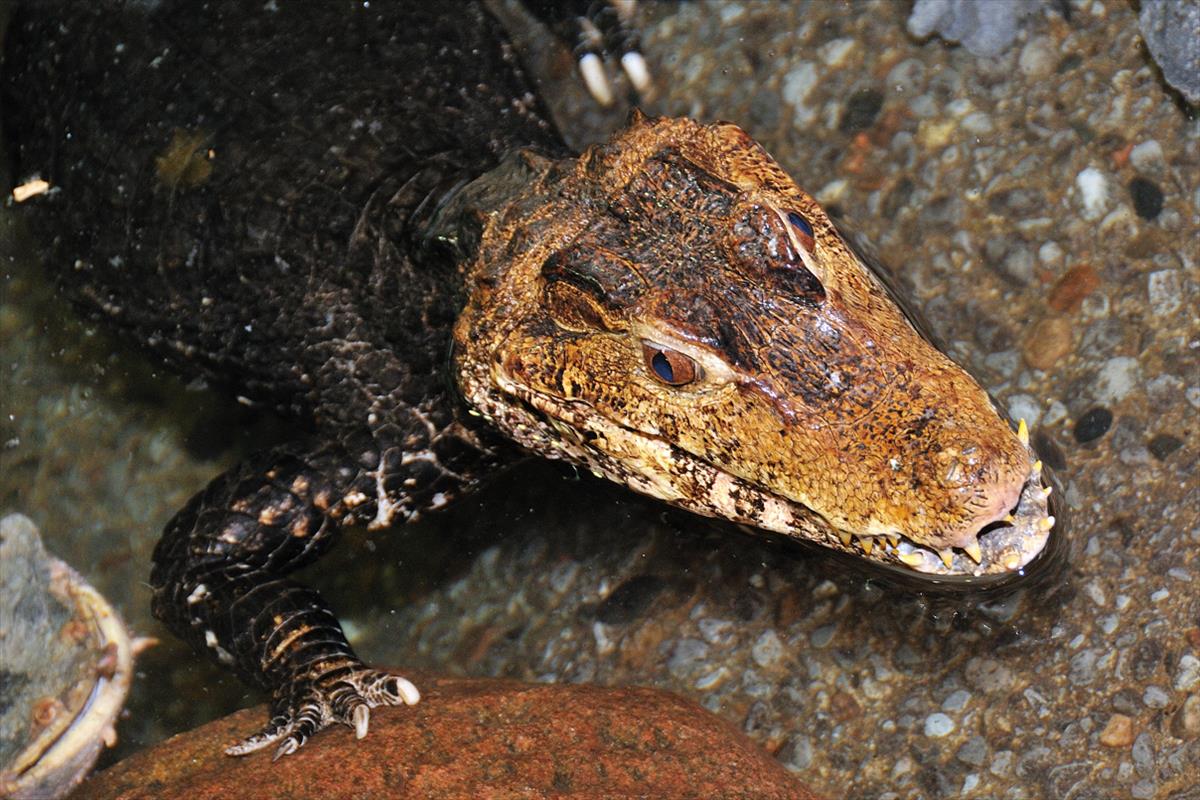Viewable


Reptile
Location at the Zoo
Americas
Global Range
South America
Cuvier's smooth-fronted caiman (dwarf caiman)
Paleosuchus palpebrosus
Order: Crocodylia
Family: Alligatoridae
Genus: Paleosuchus
Cuvier’s smooth-fronted caiman is one of the smallest caimans. Its colour is dark brown throughout its upper aspect but adults appear darker than juveniles. The sides are lighter with the undersides yellow, tan or cream. The body, including the legs, is heavily armoured by overlapping scales. These are supported by a tough skin impregnated by thick osteoderms (Latin: osteo = bone, derma = skin). The scales are joined at their edges by pliant sutures which allow for flexibility. The snout is short, smooth and V-shaped. The nostrils turn upward and are not completely divided. There is no evidence of a bony prominence around the eyes or across the nose, hence the name smooth- fronted. The skull is topped by a reddish brown cranial table. The ears are protected by coverings of a similar colour. The upper jaw clearly overlaps the lower one which is striped with dark brown bands; whitish flecks are visible at its hinge. A prominent fourth tooth fits into a pit on the upper jaw and is invisible when the mouth is closed. When open, it reveals a series of pimple-like structures on the lips known as integumentary sense organs. As well, the mouth contains 70 to 80 prominent, sharp backward leaning teeth. The large eyes face forward, high on the skull, their irises, brown; the pupils vertical slits. The cornea is covered by a nictitating membrane and the upper lids are heavily ossified bony flaps. The legs each have five clawed digits.
Length: Males 1.3-1.5m; Females 1.2m; Hatchlings: 23cm approximately.
Weight: Adults 6-7kg.
Length: Males 1.3-1.5m; Females 1.2m; Hatchlings: 23cm approximately.
Weight: Adults 6-7kg.
Conservation Status: IUCN

Distribution
These reptiles can be found throughout northern South America in the Amazon and Orinoco River basins as well as regions of the Parana and Sao Francisco River drainage area.Habitat
This species inhabits remote tropical rainforests preferring deeply shaded, fast-moving streams and rivers lined with gallery forests. They are also found in swamps and along muddy banks that are littered with fallen trees and branches. Smooth-fronted caiman also move throughout flooded forests and ponds during the wet season when water courses overflow.Diet
This species is an opportunistic feeder. The young consume invertebrates, small fish, crustaceans and mollusks. Adults take snakes, turtles, water fowl, wild pigs and capybara.Reproduction
The climate of the tropical rainforest can support mating throughout the year but it is usually timed so that the young will emerge from the nest at the beginning of the rainy season. During mating and courtship, males will challenge intruders and act aggressively. Pairs come together at night in the water swimming close to each other with the male emitting grunt-like nasal “chumphs”. They adopt a side by side posture with cloacae touching. This coupling lasts for about 10 to 15 minutes and is repeated four or five times over a few days. The female then moves off and finds a hidden site above the high water line on which to build a mound nest but often renovates an abandoned one. She scrapes together rotting plant material, fresh mud and green vegetation. On top she makes a smaller nest into which her eggs are deposited. Occasionally, she will scoop a small depression into soft soil. A different third site may be chosen: a floating island of green and rotting debris (a cameletta) where she builds a nest. Into it she deposits approximately18 to 25 white, oblong tough-shelled eggs and covers them. Warmth is maintained by decomposing nest material. Sex is determined by temperature with cooler temperatures producing females and warmer producing males. Incubation lasts about three months, with the female guarding her eggs. She warns intruders off through jaw dropping and tail splashing as well as aggressive charges from the water. When the young are ready to emerge, they begin to vocalize and scratch at their egg shells using a temporary egg tooth (a carnuncle). The mother then uncovers them. Further maternal supervision is uncertain. The young caiman then begin an extremely hazardous life, eating voraciously. Growth is fastest in the first two years of life; sexual maturity is unlikely before 10 years of age.Adaptation
Cuvier’s smooth-fronted caiman is well suited to its life in the tropical rainforest. It never lives far from water. Although small, it is strong and tough with body armour on both dorsal and ventral surfaces that protects it from being injured by predators and turbulent currents. The pliant sutures that edge each scale allow for flexibility. The fused skull gives strength in rough water as well as in digging burrows for protection from the day time heat. Its dark brown colour is well suited for shaded water murky with forest run off and turbulence. Although short sighted beneath the surface, a nictitating membrane improves underwater vision. Thickly ossified lids protect their eyes from injury. Situated, as they are, high on the skull and facing forward, they give the caiman binocular vision. The upturned nostrils allow for breathing while awash in the water and they can be closed while submerged. Their ear coverings keep water out as well. The caiman’s vertical pupils are designed for night vision. It hunts, mates, and moves overland nocturnally, often for long distances, to find new space and avoid competition for food. Its integumentary sense organs taste the caiman’s surroundings when its eyes are closed underwater. They tear food into chunks but do not chew.While P. palpebrosus does not live in closely knit groups, dominant males, using a hierarchical structure, will try to control individuals living in his territory by withholding access to mates, nesting sites and food sources. Challenges occur but physical combat is rare. Hostility is expressed through inflating the body, hissing and vertical displays of size on the surface of the water. Jaw dropping and tail thrashing also signal aggression and warn competitors away from mates and established territories. Mound nests built above the high water mark are an effective way to protect eggs from the danger of drying out or drowning and deter predation. The camelettas give hatchlings protection, access to food and allow for exploration of their aquatic environment. The banded colour patterns on the young and juveniles help obscure them while in the water. The light coloured under belly and dark upper torso supply camouflage from below and above (counter shading).












